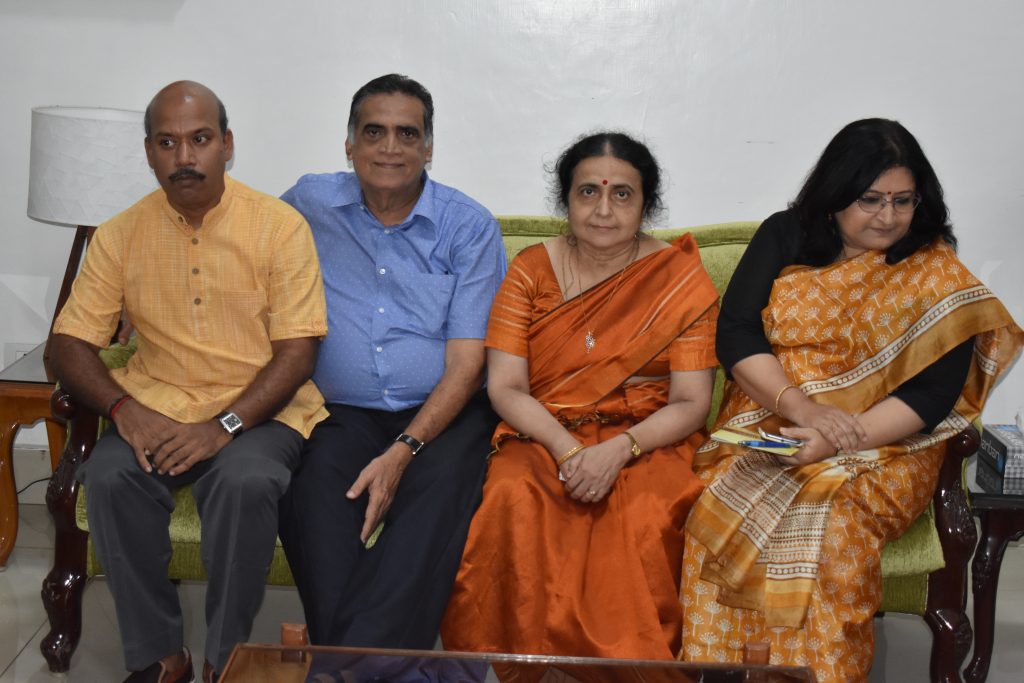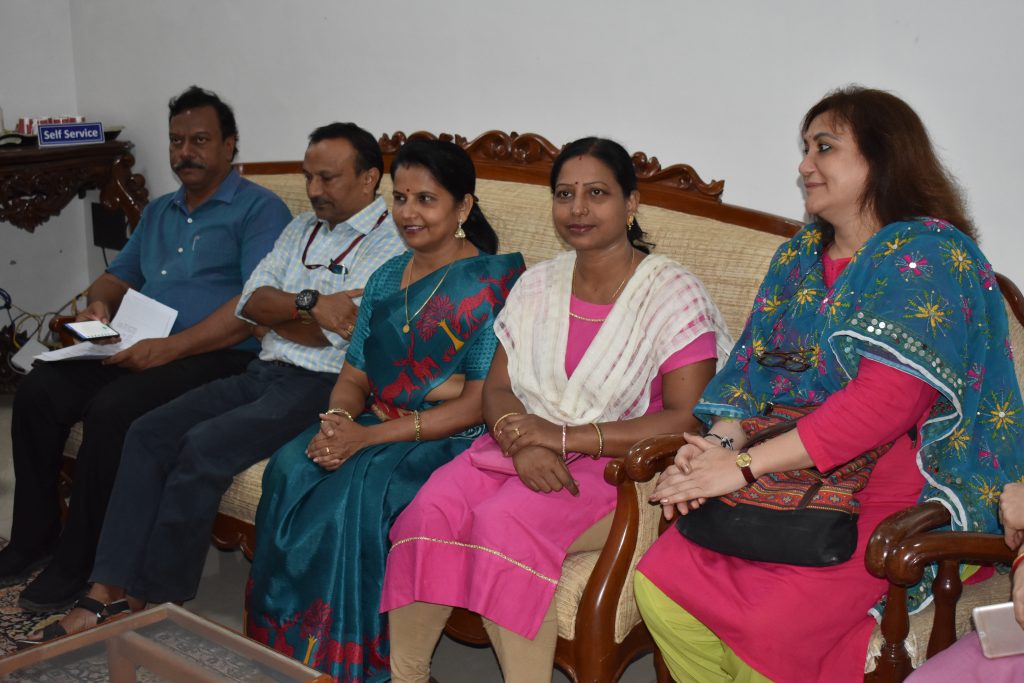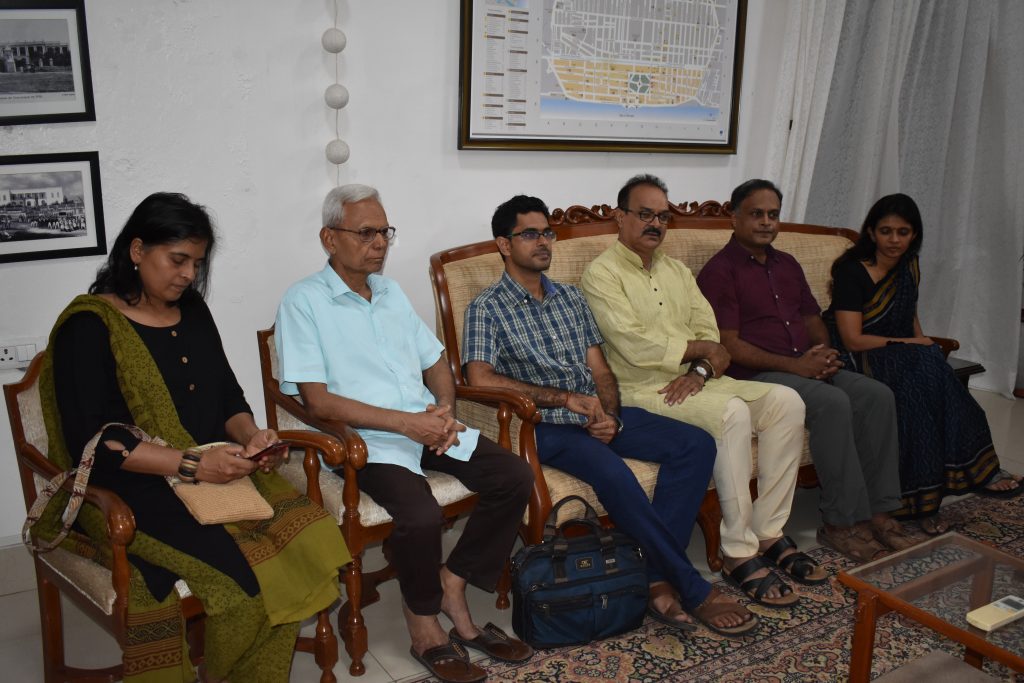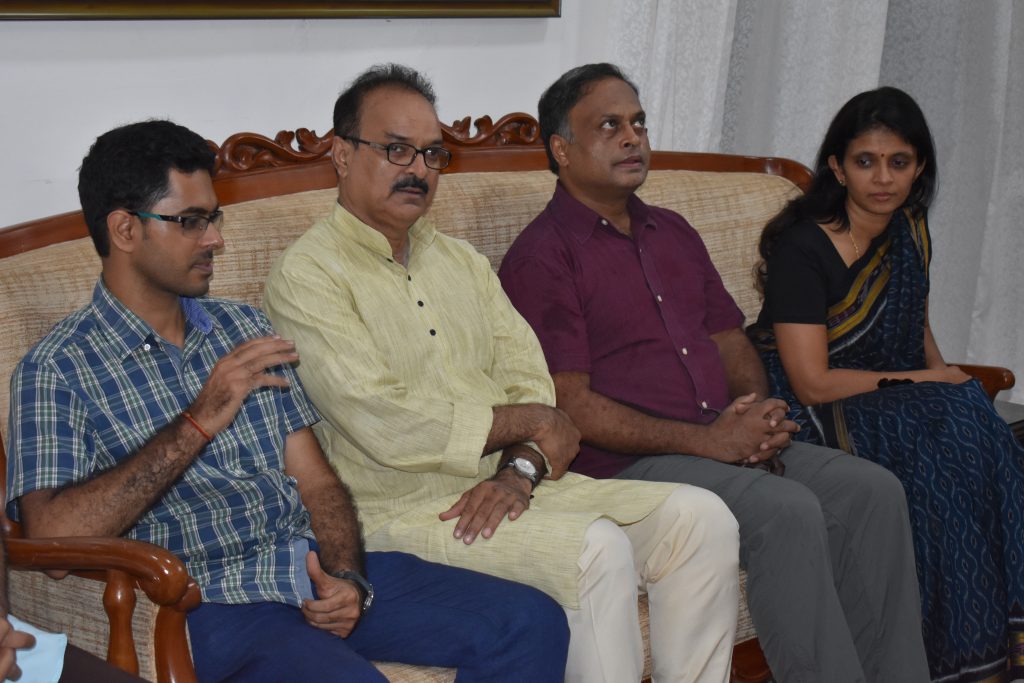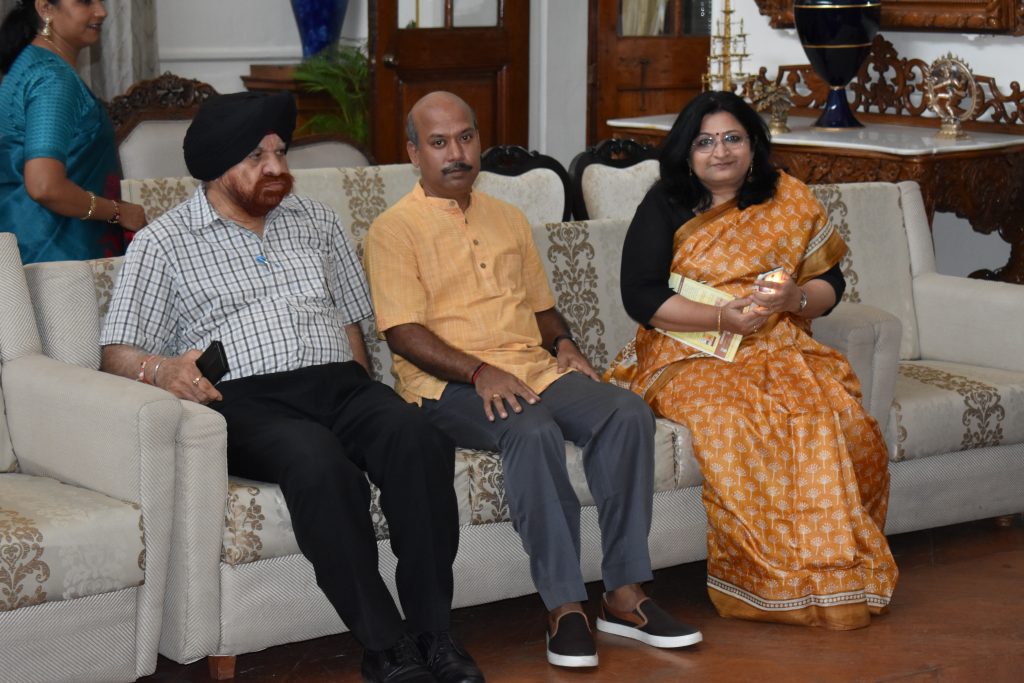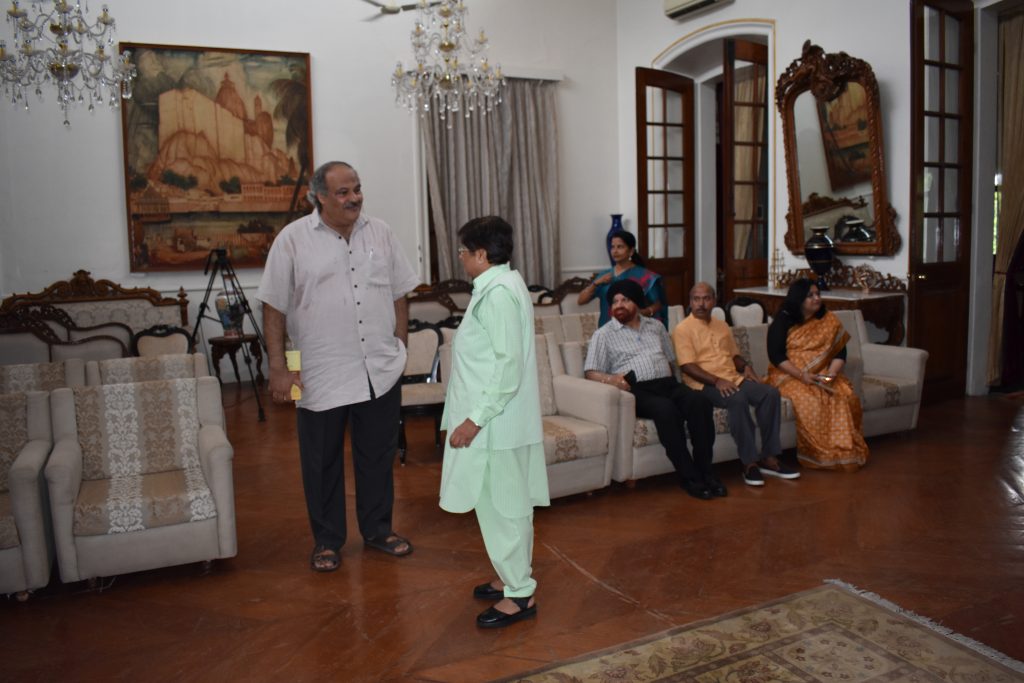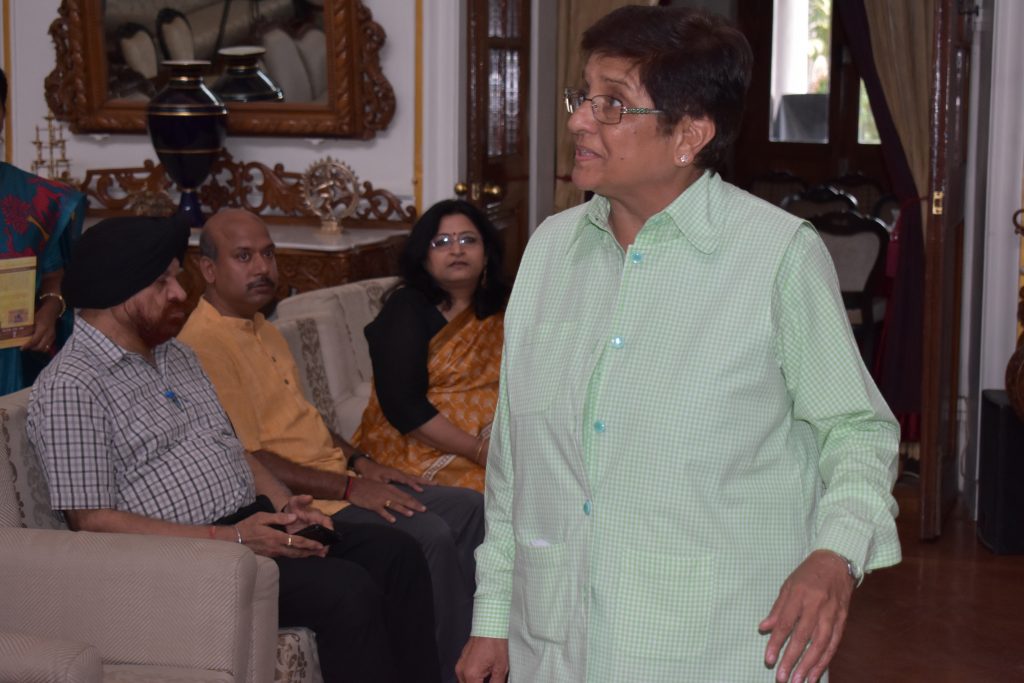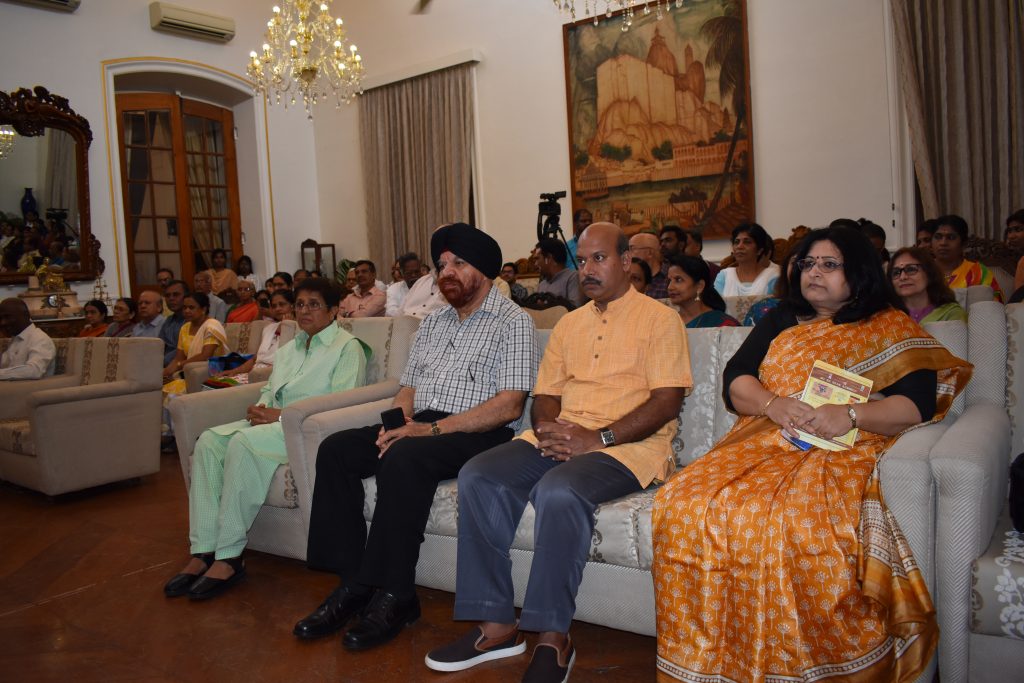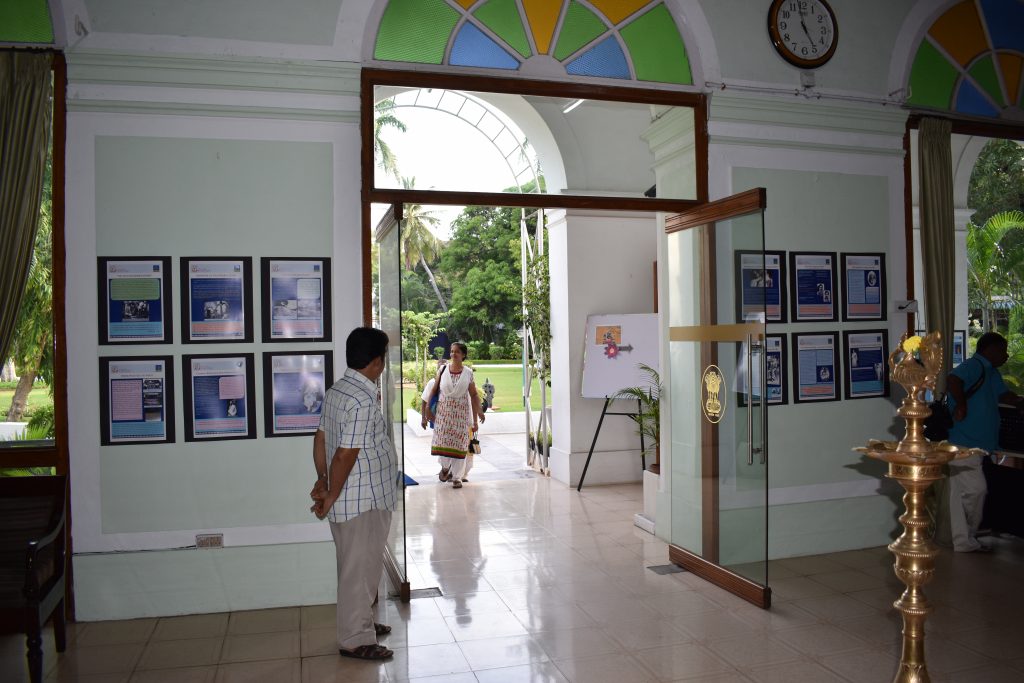Date: September 6, 2019
Venue: Raj Nivas, Puducherry
Hon’ble Lt. Gov. of Pondicherry, Dr. Kiran Bedi ji, Raj Nivas invited Sri Aurobindo Society to present two poster exhibitions as part of Raj Nivas Art and Culture Series, Edition 13, and also deliver two lectures as part of Raj Nivas Leadership and Lecture series, Edition 12. This event was scheduled at 5:00 PM on September 6, 2019.
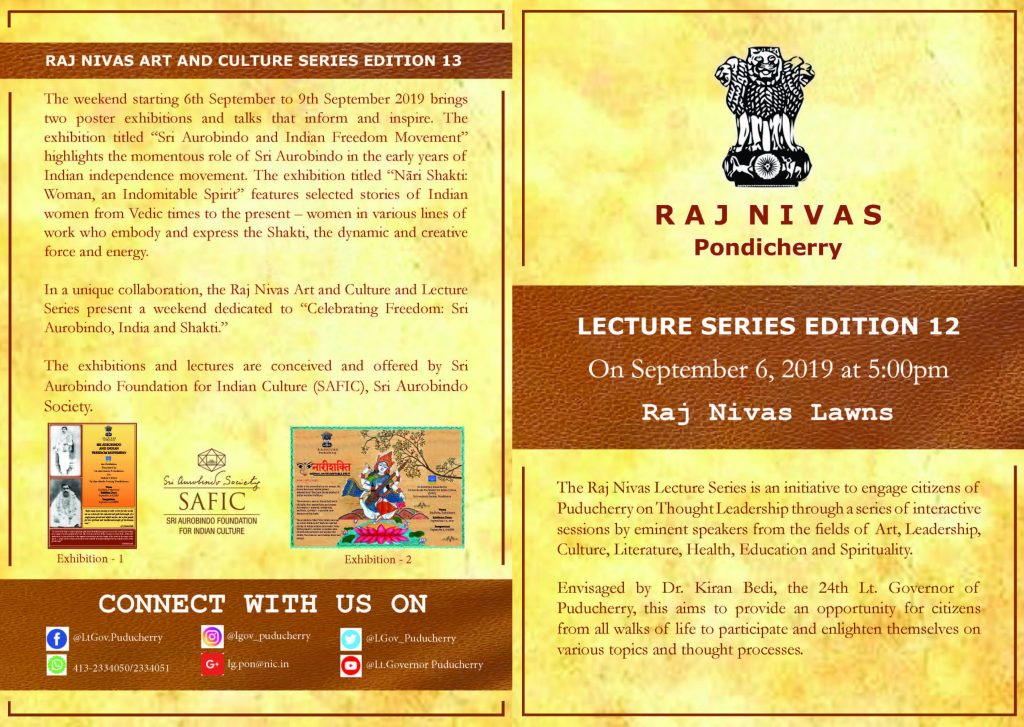
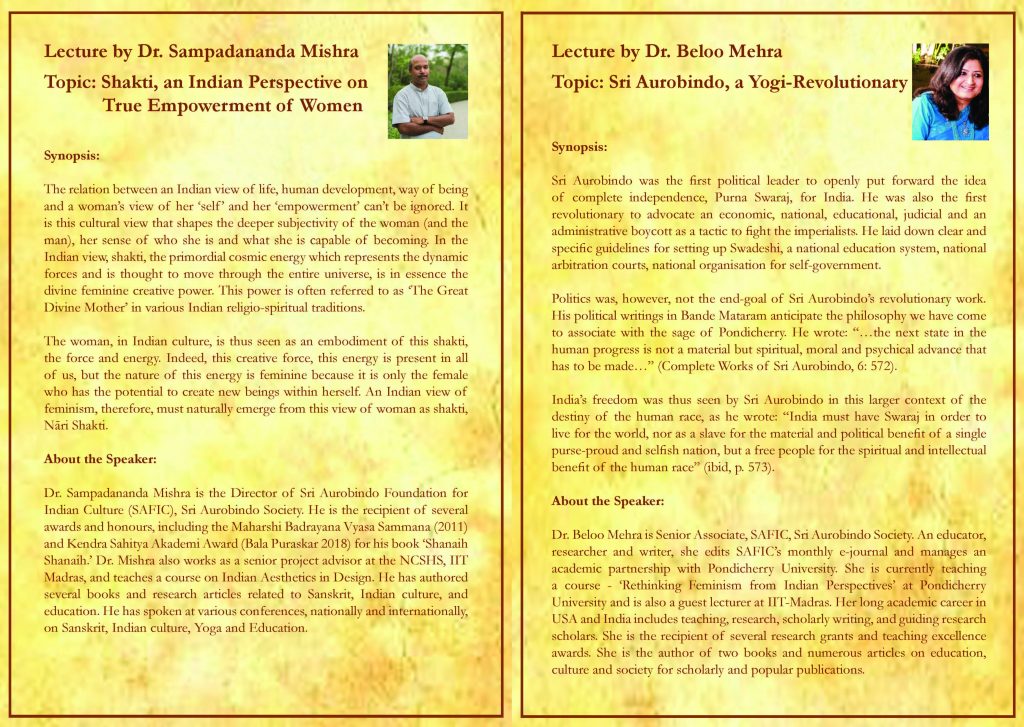
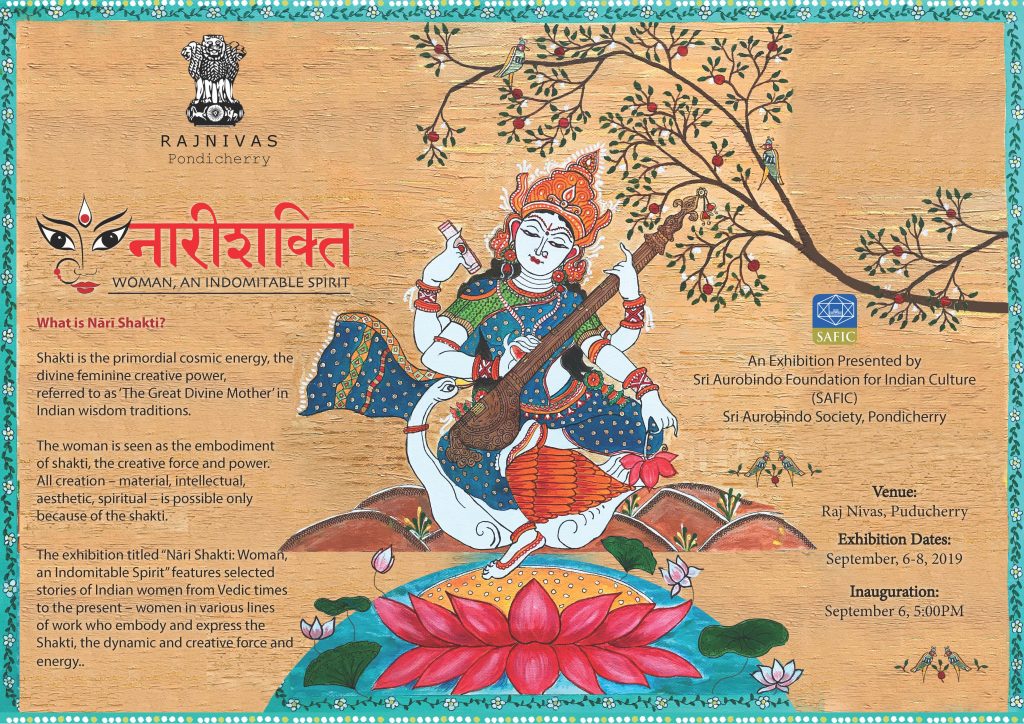
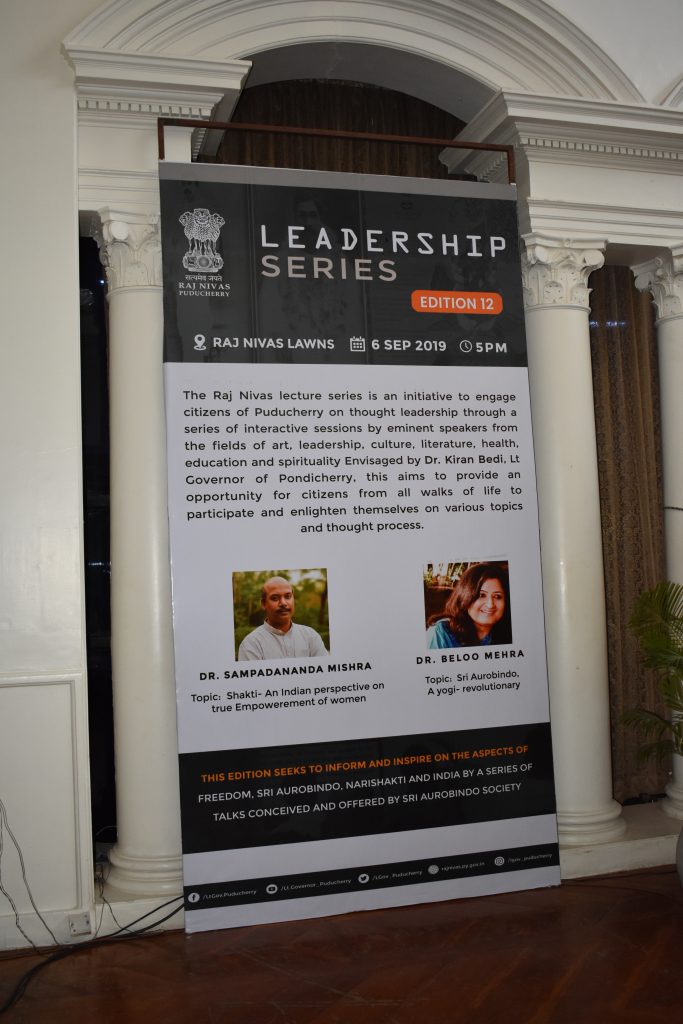
Exhibitions
The two exhibitions are: Sri Aurobindo and Indian Freedom Movement; and Nāri Shakti – Woman, an Indomitable Spirit.
The poster exhibition titled “Sri Aurobindo and Indian Freedom Movement” highlights the momentous role of Sri Aurobindo in the early years of Indian freedom movement. A specific time period, 1893 to 1910, has been selected to weave together a narrative to highlight the significant political and revolutionary activities of Sri Aurobindo. Historical material from various primary and secondary sources is organised and presented, including important passages from Sri Aurobindo’s political speeches through the posters.
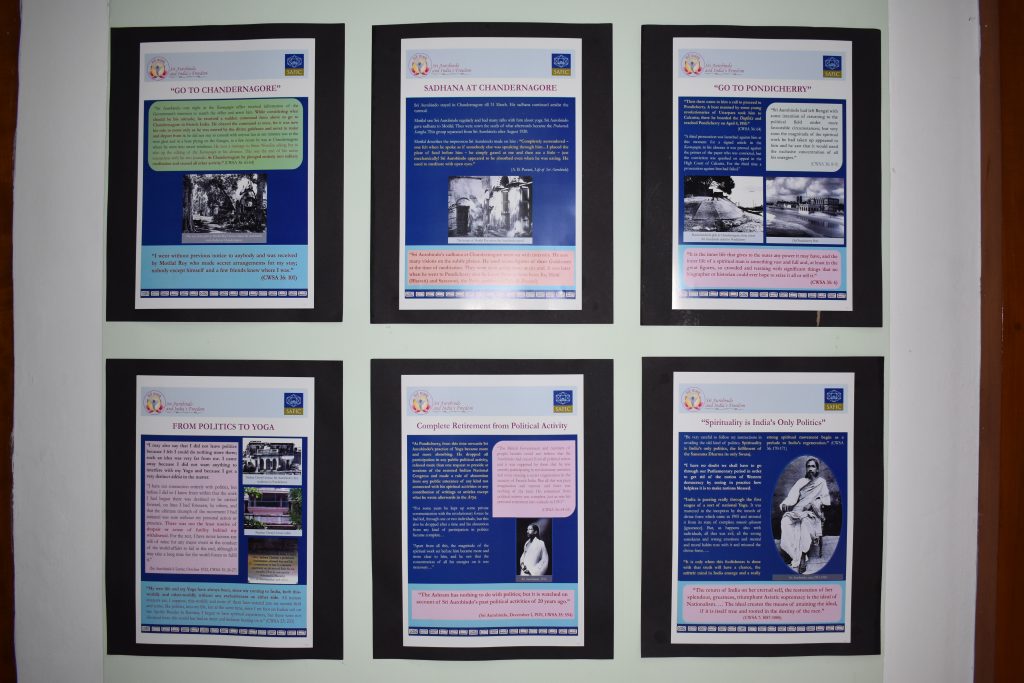
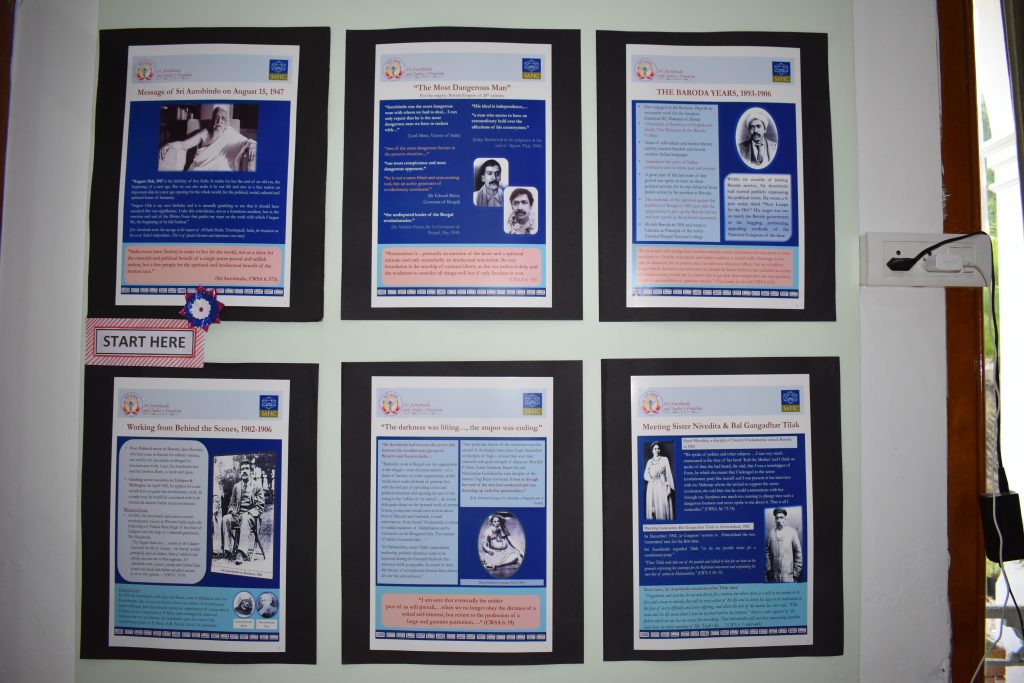
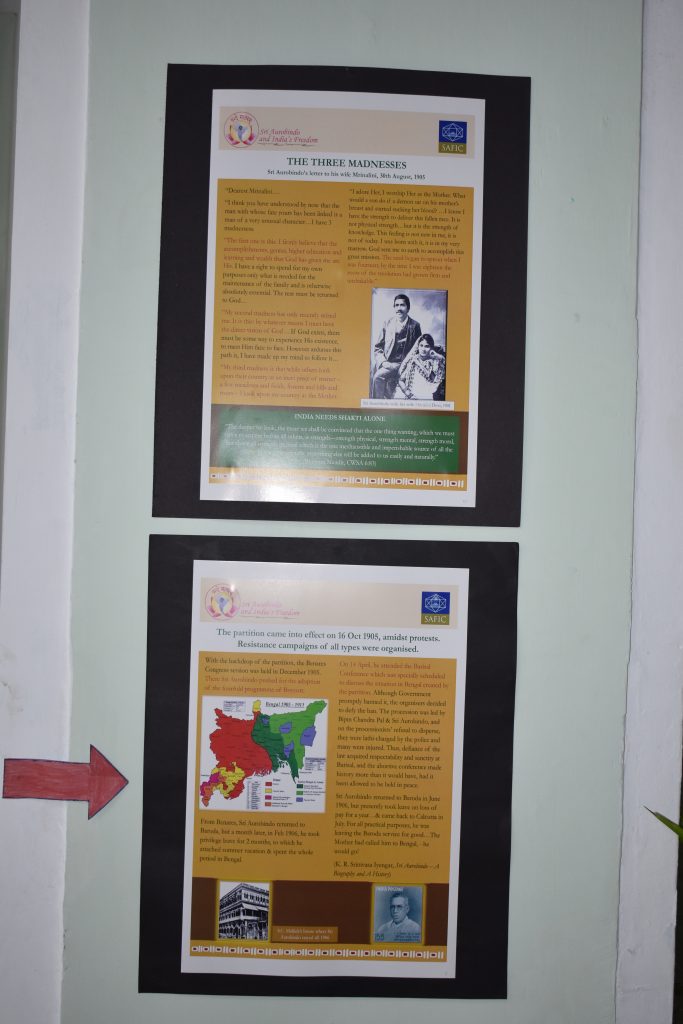
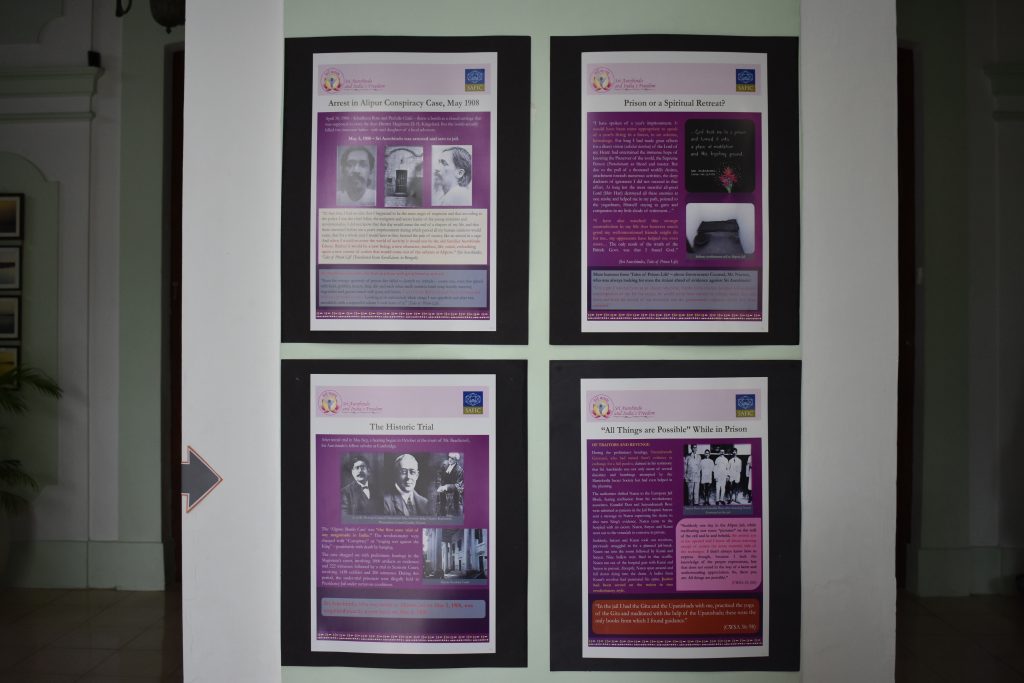
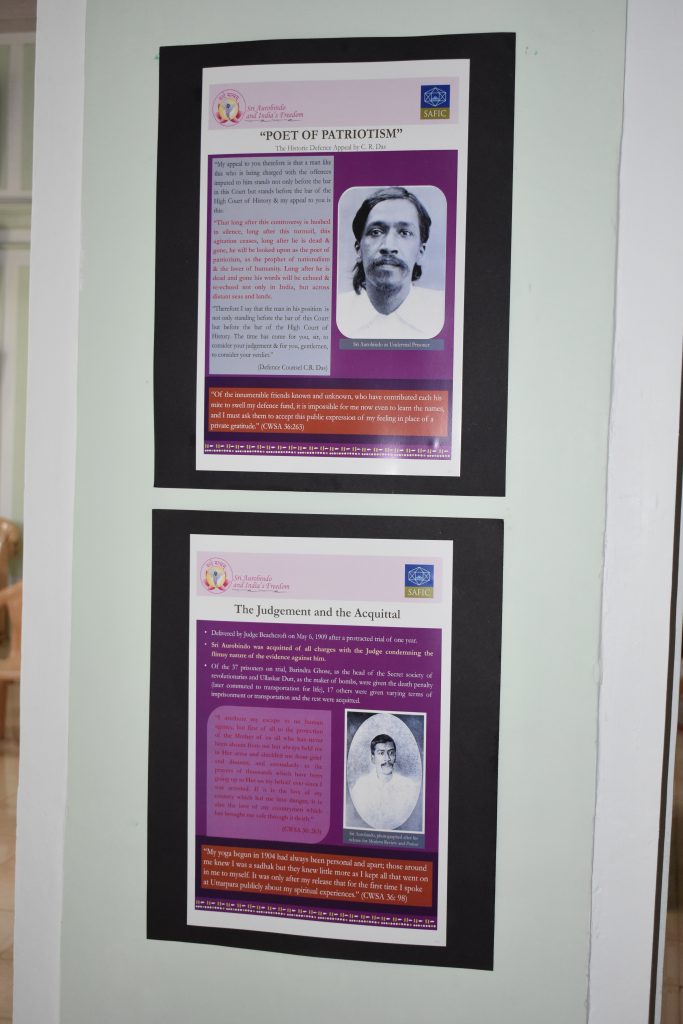
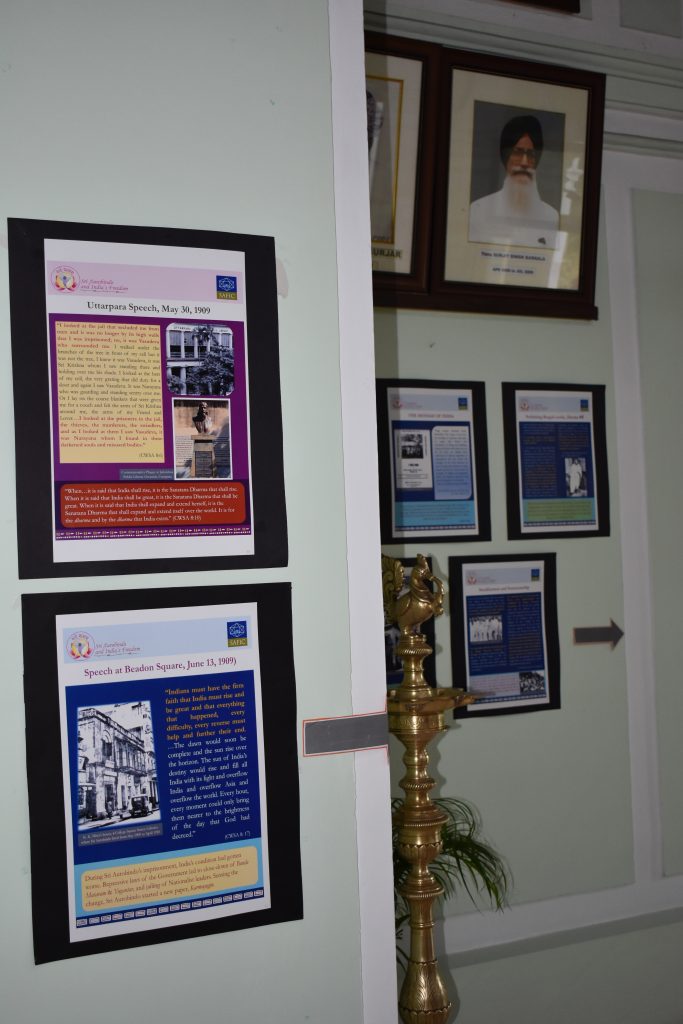
The poster exhibition titled “Nāri Shakti: Woman, an Indomitable Spirit” is inspired by the idea of Shakti, the primordial cosmic energy which represents the dynamic forces that move through the entire universe. Guided by Sri Aurobindo’s description of the Four Great Powers of the great Mahashakti, this exhibition highlights selected stories of Indian women from Vedic times to the present – women who embody and express one or more powers of the Mahashakti through their chosen field of work, who reflect one or more of these powers through their very presence.
The Programme
The programme on September 6 began with the inaugural lamp lighting ceremony, to officially open the exhibitions at the reception hall of Raj Nivas. Hon’ble Prof. Gurmeet Singh, Vice-Chancellor of Pondicherry University was also present for this programme. SAFIC has been conducting several programmes at Pondicherry University, so it was a special delight to have him present at this important event. Both the poster exhibitions were first displayed at Pondicherry University.
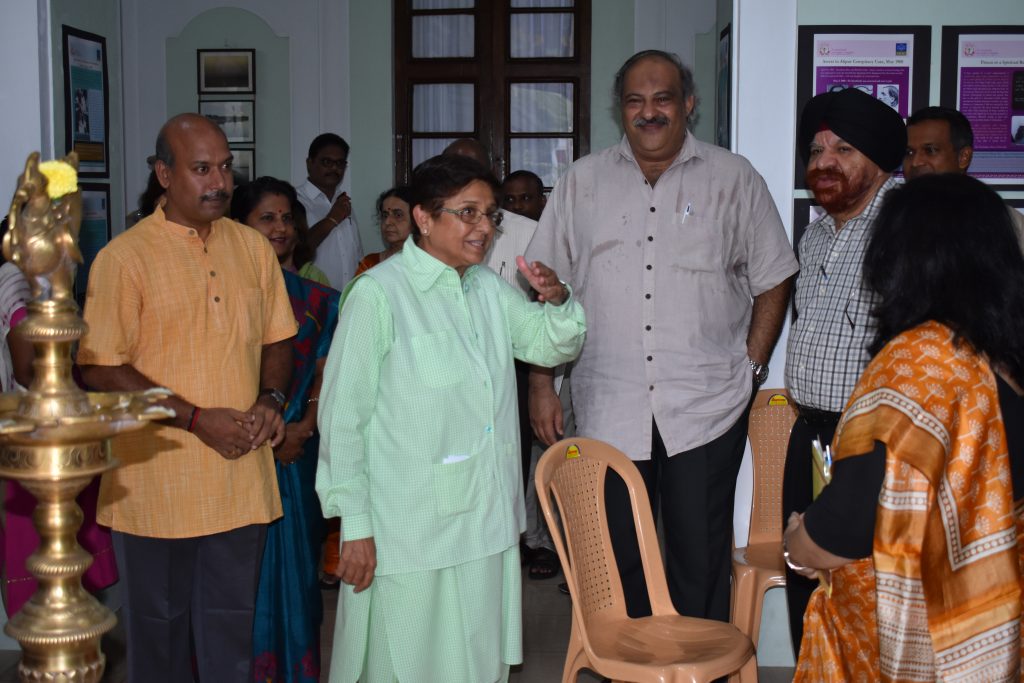
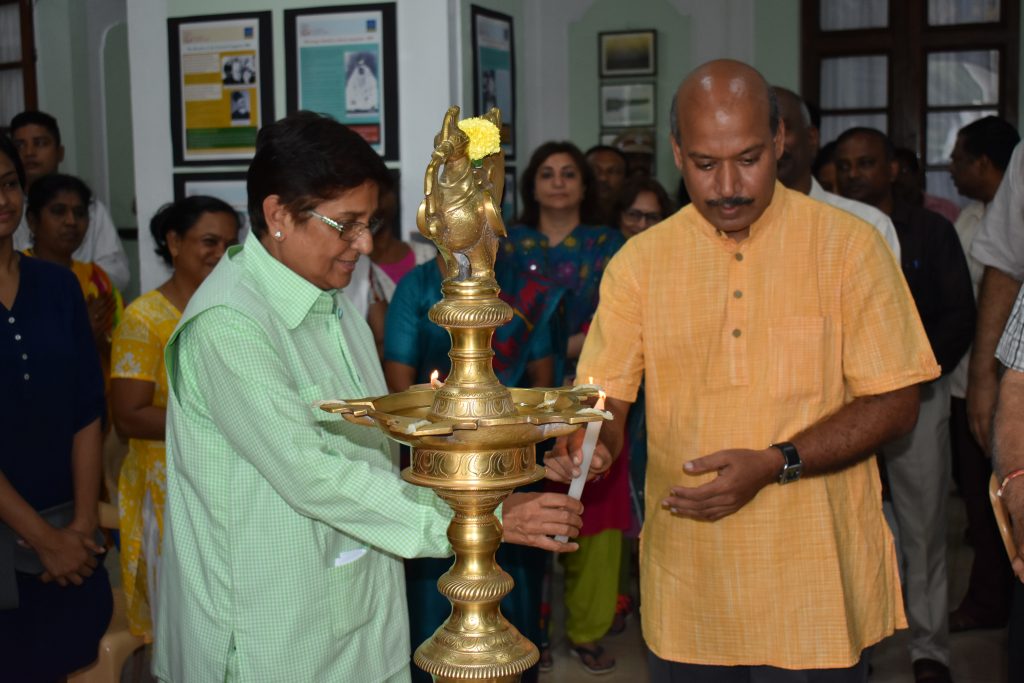
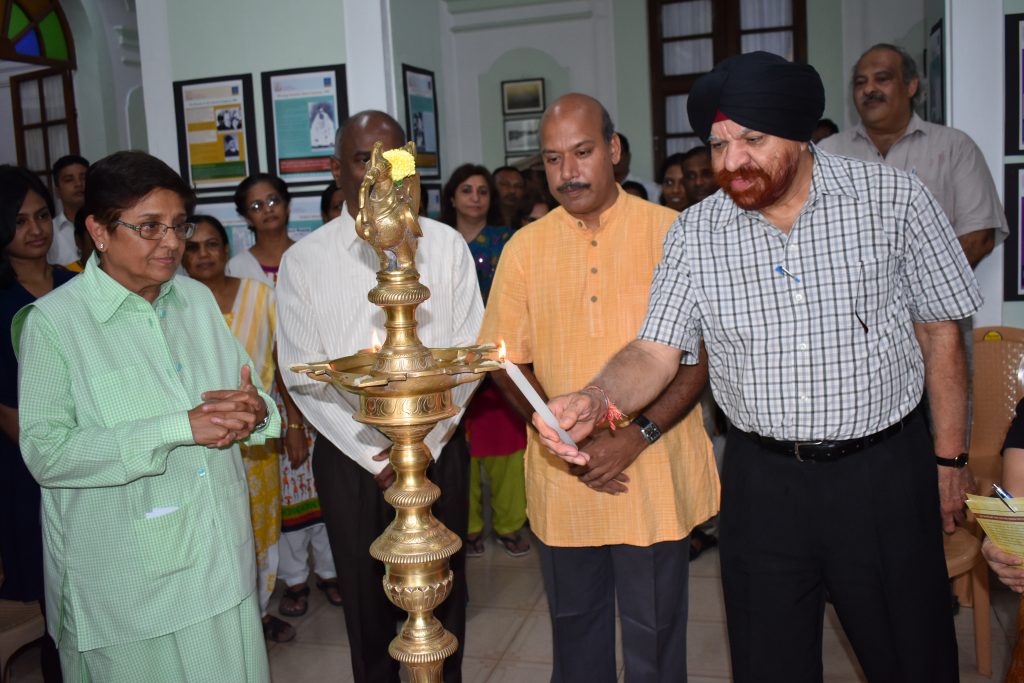
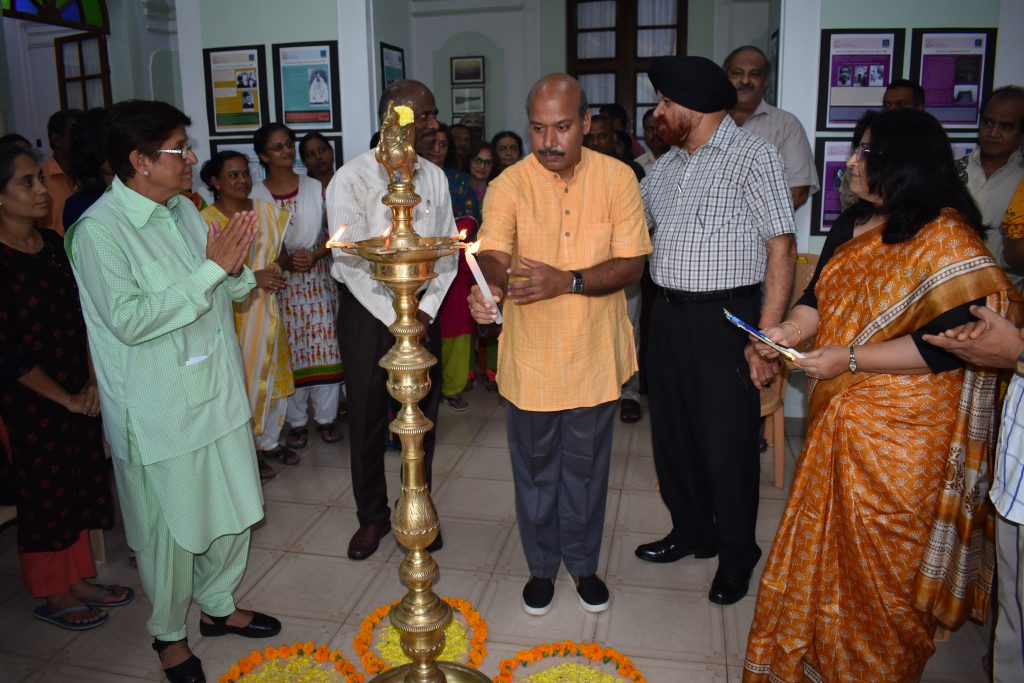

After the lighting of the lamp, all the guests were taken to Darbar Hall where the lectures were arranged. Ms. Asha Gupta, Comptroller of the Household, Raj Nivas, officially welcomed the guests.
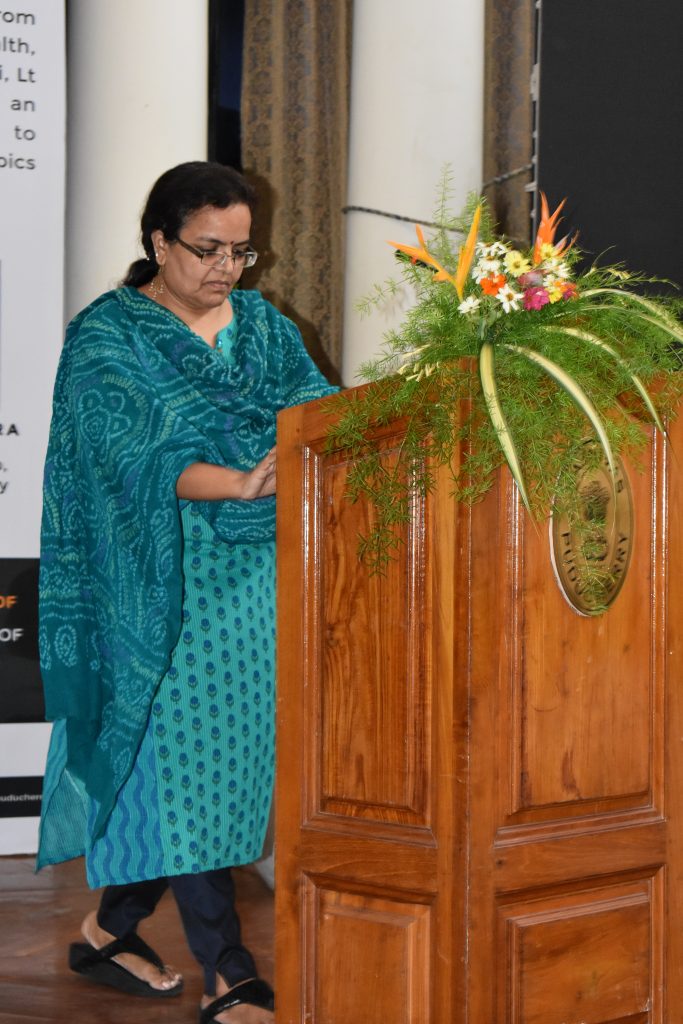
The programme began with a Vedic invocation offered by the young students of a Veda Pathashala in town. This set the serene and sublime tone for the entire evening.
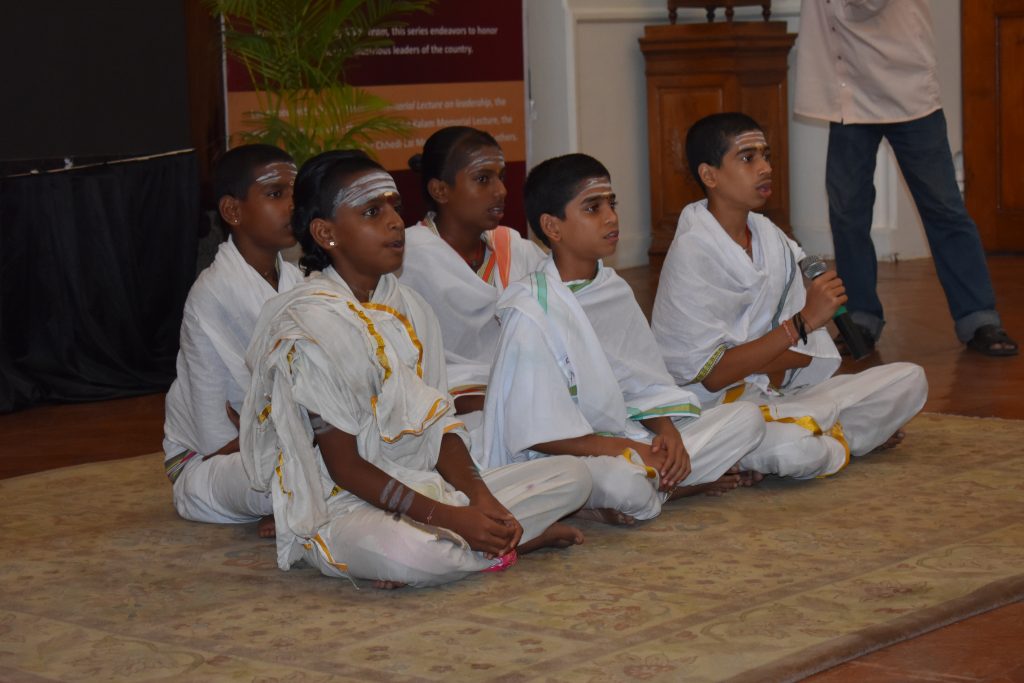
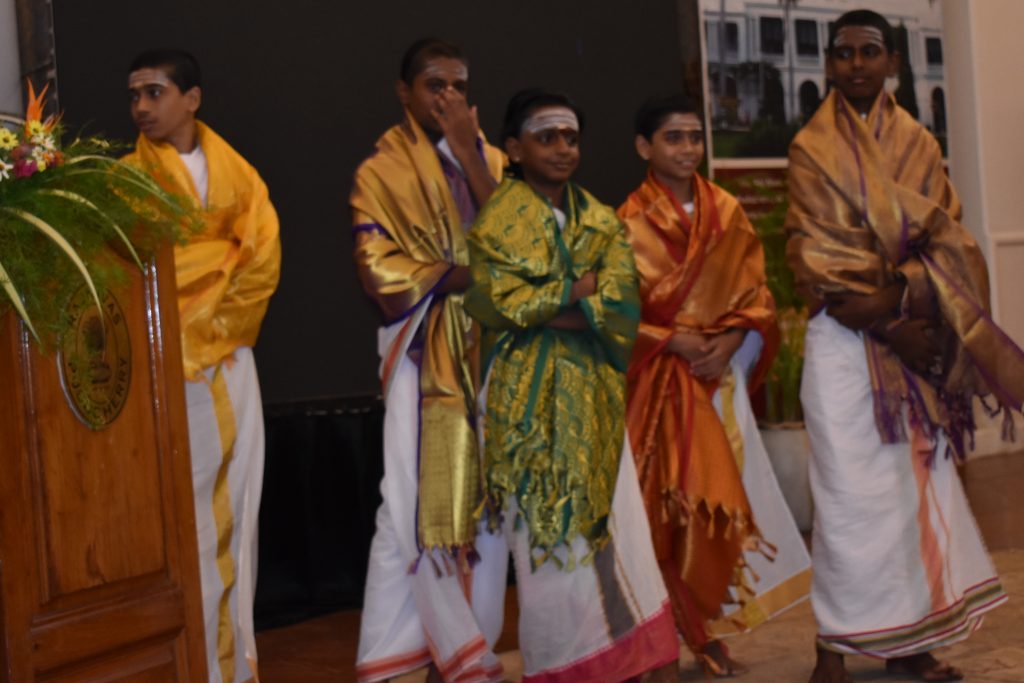
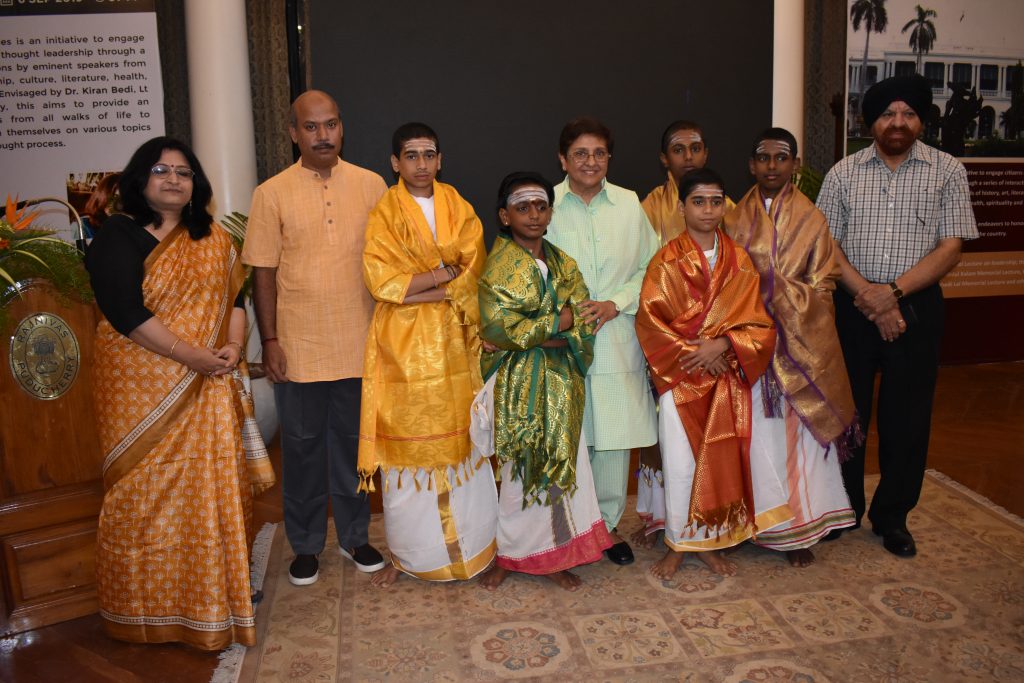
Mr. G. Theva Neethi Dhas, OSD (Officer on Special Duty to Lt. Governor) then introduced the programme, briefly mentioning the inspiration behind the Raj Nivas Lecture Series and Art and Culture Series. He spoke of the relevance of both the themes that were highlighted in the evening’s programme. He recounted the significance of Pondicherry in the history of Indian freedom movement as being the place which gave shelter to two key revolutionaries – Sri Aurobindo and Subramanian Bharati. He briefly spoke of the friendship and camaraderie that the two shared including their regular meetings at Sri Aurobindo’s residence.
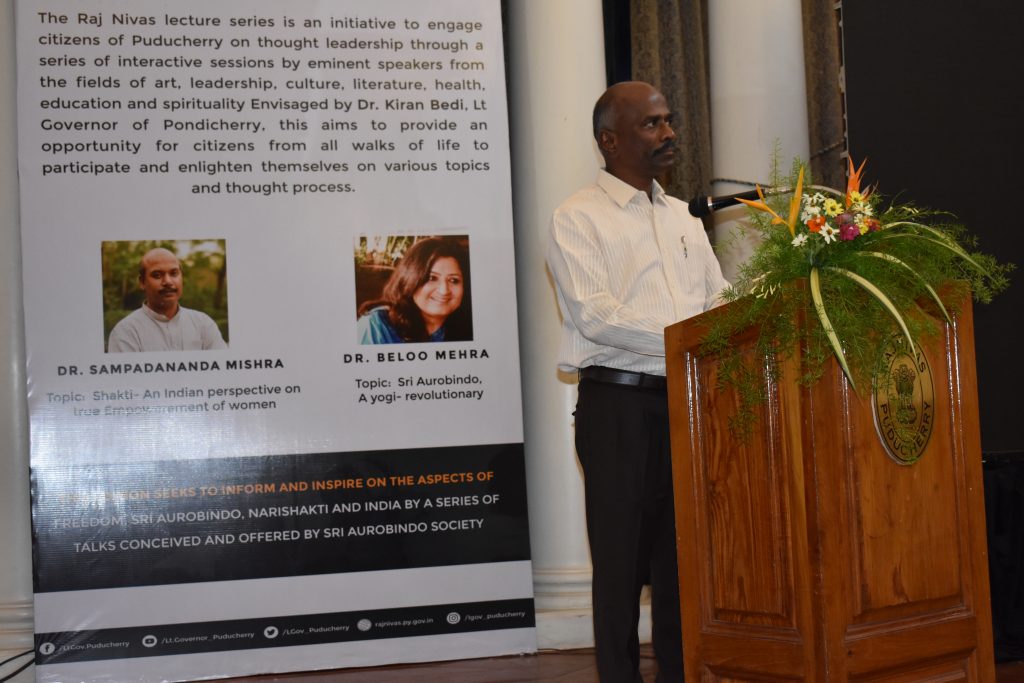
He also mentioned that through various types of outreach activities, Raj Nivas, under the leadership of Dr. Kiran Bedi, has been encouraging the people of Puducherry, especially the youth, to deepen their knowledge of the history of Puducherry, history of India and awaken the love for motherland.
Lecture 1
Ms. Asha Gupta then invited Dr. Beloo Mehra to deliver her lecture on the topic – “Sri Aurobindo, a Yogi-Revolutionary.”
In her lecture, Dr. Mehra summarised and highlighted a few key points from the great contribution of Sri Aurobindo to India’s freedom movement. She began by sharing that in Sri Aurobindo’s vision India’s rise to greatness, power and prosperity – not only material but in all ways – intellectual, cultural and most importantly spiritual – is for a larger role that she must fulfil for the world and humanity. It is this vision of India in which, she said, we must understand Sri Aurobindo’s significant role in India’s freedom movement. If India had to be the world’s spiritual guru, the first and most essential work was to make India free.
She reminded the audience that it was the yogi in Sri Aurobindo which made his revolutionary work visionary and highly forceful. It was his yogic strength, the absolute purity, sincerity and selflessness of his intention and work, the deepest truth of his yogic vision which saw India as a Mother, a Shakti, a power and a godhead, that made him “the most dangerous man” the British colonial government ever had to contend with.
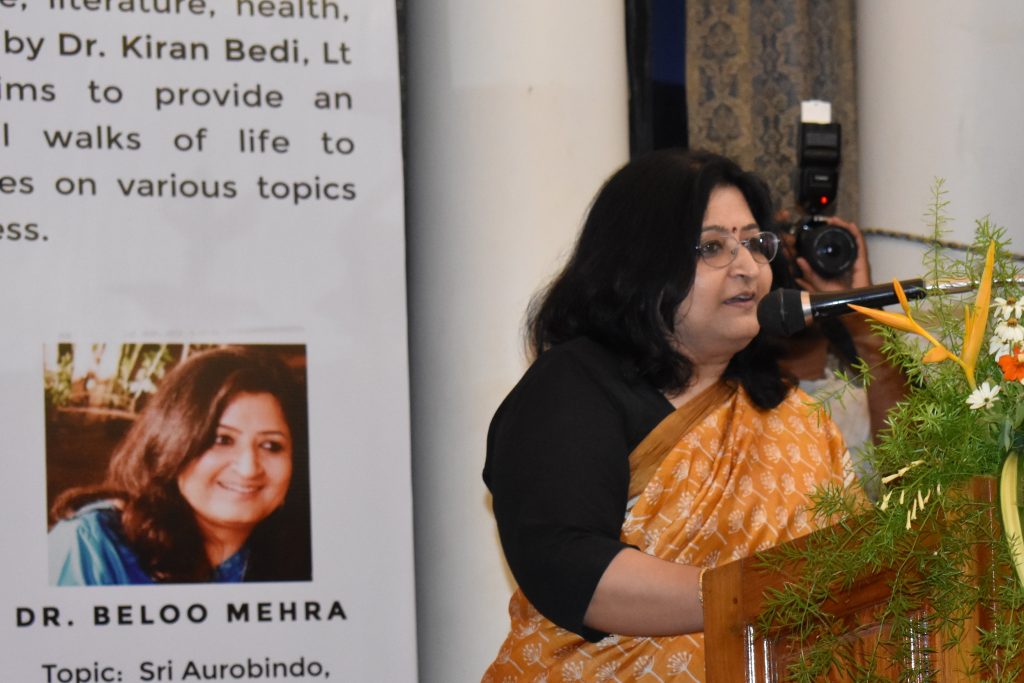
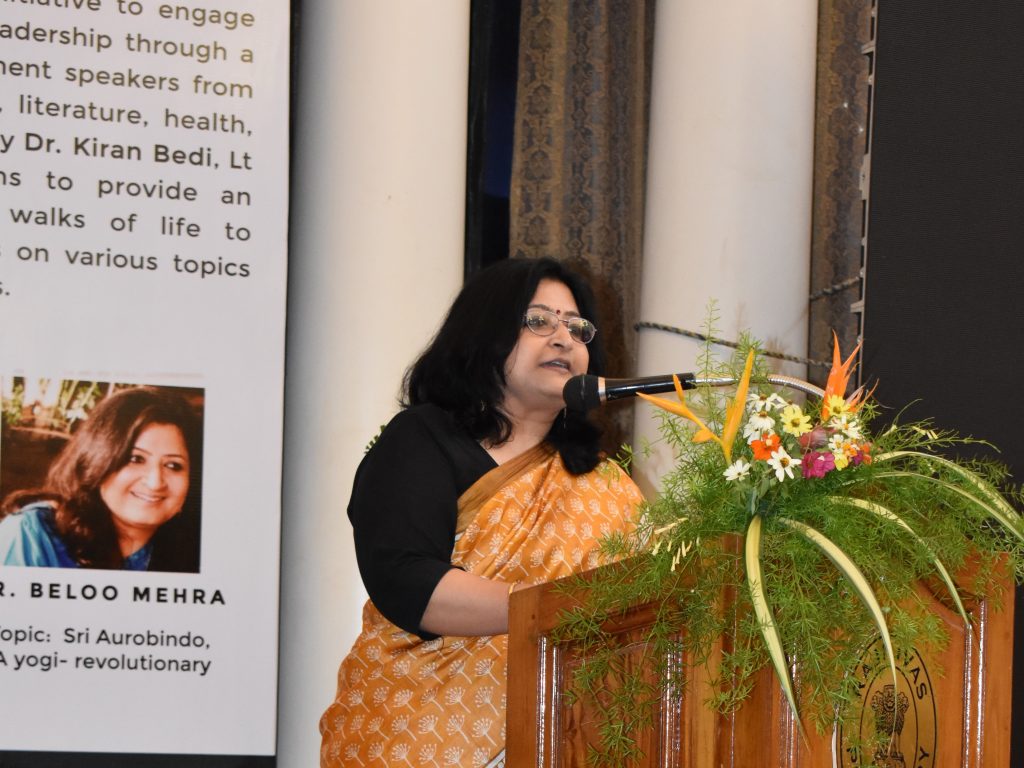
It was pointed that Sri Aurobindo was the first political leader to openly put forward the idea of complete independence, Purna Swaraj, for India. He was also the first revolutionary to advocate an economic, national, educational, judicial and an administrative boycott as a tactic to fight the imperialists. He laid down clear and specific guidelines for setting up Swadeshi, a national education system, national arbitration courts, national organisation for self-government.
But politics was never the end-goal of Sri Aurobindo’s revolutionary work, Dr. Mehra said in her lecture. Sri Aurobindo saw India’s freedom in the larger context of the destiny of the human race and the role India was destined to play as a custodian of the Supreme Knowledge and as a leader of the human race in ways of the spirit.
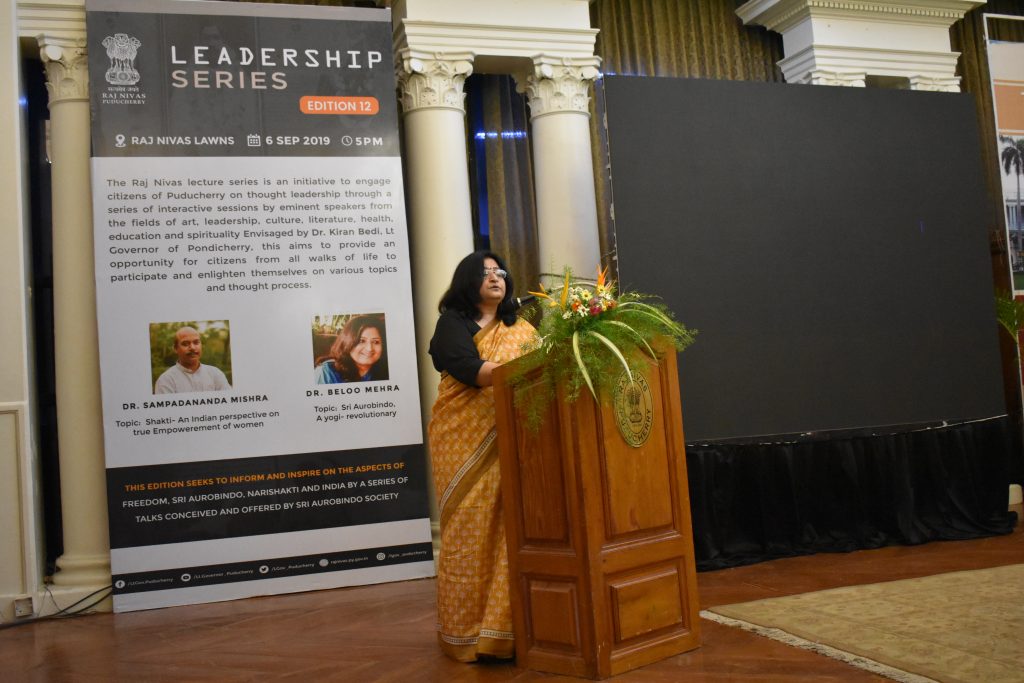
Throughout her speech, Dr. Mehra shared some relevant excerpts from Sri Aurobindo’s political writings and speeches, as well as some of his key correspondences about his revolutionary work, including the decision to leave politics.
Dr. Kiran Bedi honoured Dr. Mehra by presenting a shawl.
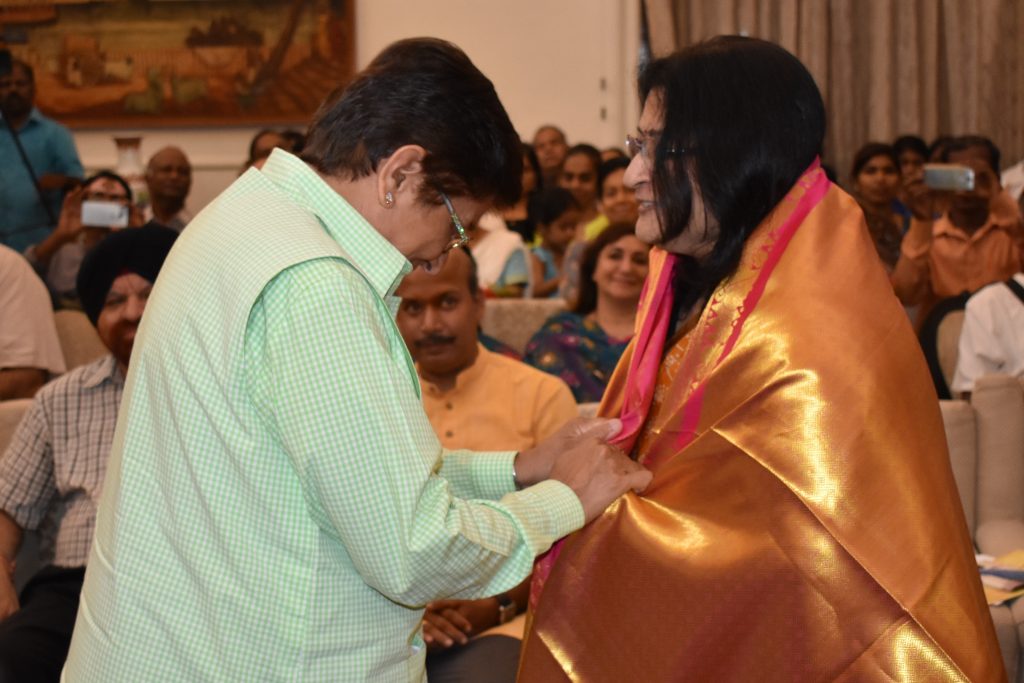
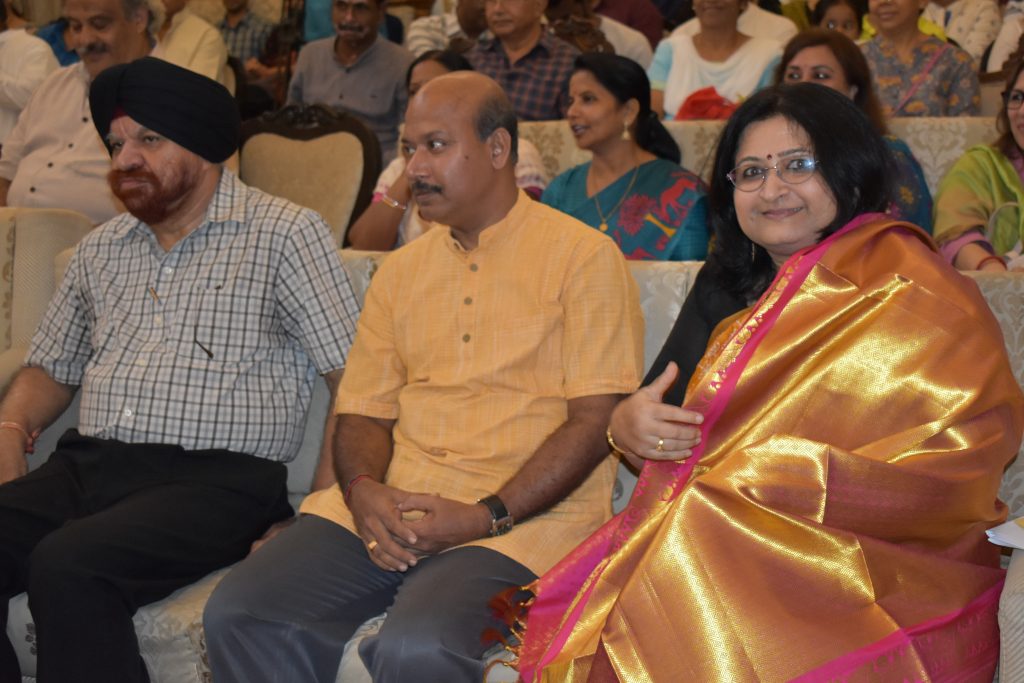
Before the start of the next lecture, a short video clip about Nari Shakti was shown. This and another video clip were selected by Dr. Mehra and provided to Raj Nivas team ahead of time.
Lecture 2
Ms. Asha Gupta then invited Dr. Sampadananda Mishra to deliver his lecture on the topic – “Shakti, an Indian Perspective on True Empowerment of Women”
Dr. Mishra began his lecture by invoking the Divine Mother. He said that as a student of Sanskrit, he is always keen on going to the root meaning, the very essence of the Sanskrit words. The phrase Nāri Shakti, he said, is often misunderstood to mean Shakti of Nāri, whereas the deeper truth is that Nāri herself is Shakti.
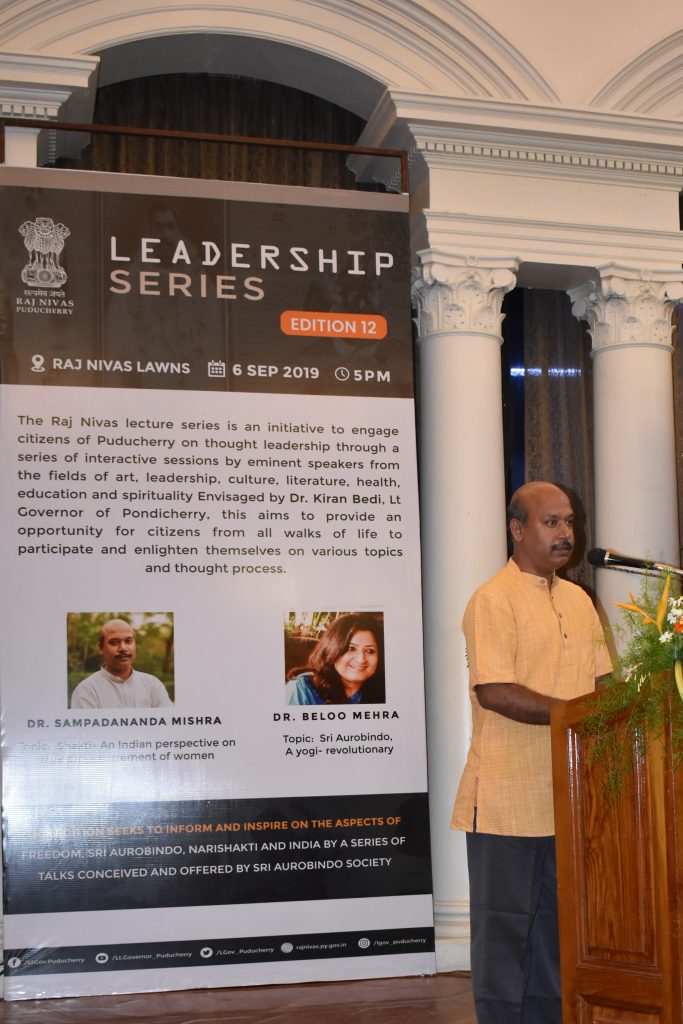
He briefly explained this significant distinction by recounting that from an Indian perspective, it is Shakti alone which has the power to create and execute the entire process of creation. In the Indian view, Shakti is the primordial cosmic energy which represents the dynamic forces and is thought to move through the entire universe, is in essence the divine feminine creative power. This power is often referred to as ‘The Great Divine Mother’ in Indian religio-spiritual traditions.
The woman, in Indian culture, is seen as an embodiment of this shakti, the force and energy. Indeed, this creative force, this energy is present in all of us, but the nature of this energy is feminine because it is only the female who has the potential to create new beings within herself, Dr. Mishra reminded the audience. An Indian view of a truly empowered woman must naturally emerge from this view of woman as shakti, nāri shakti.
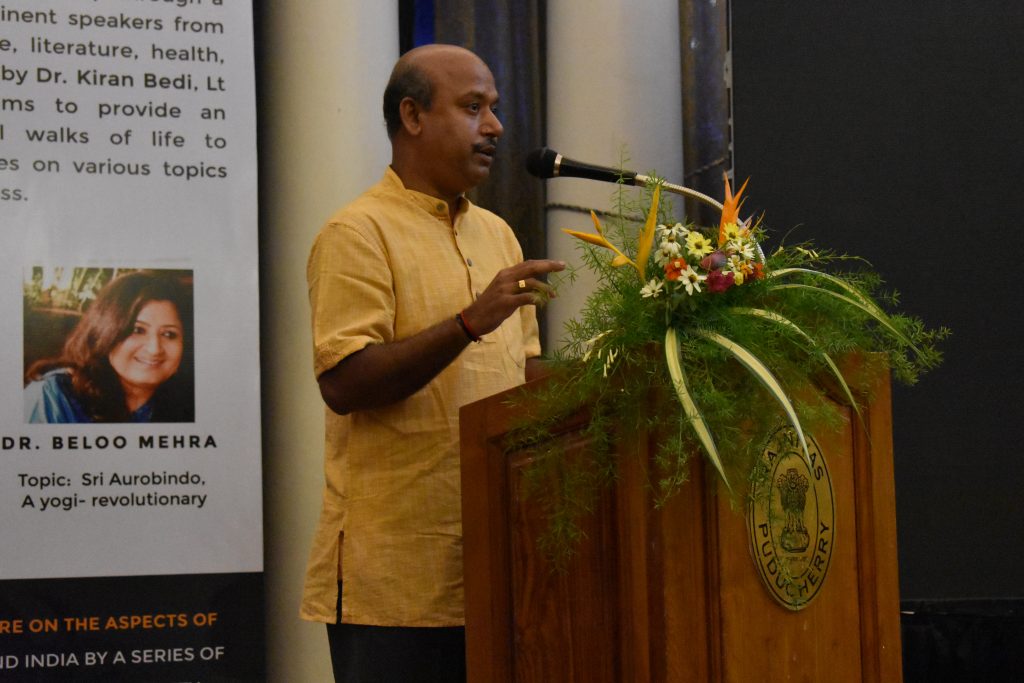
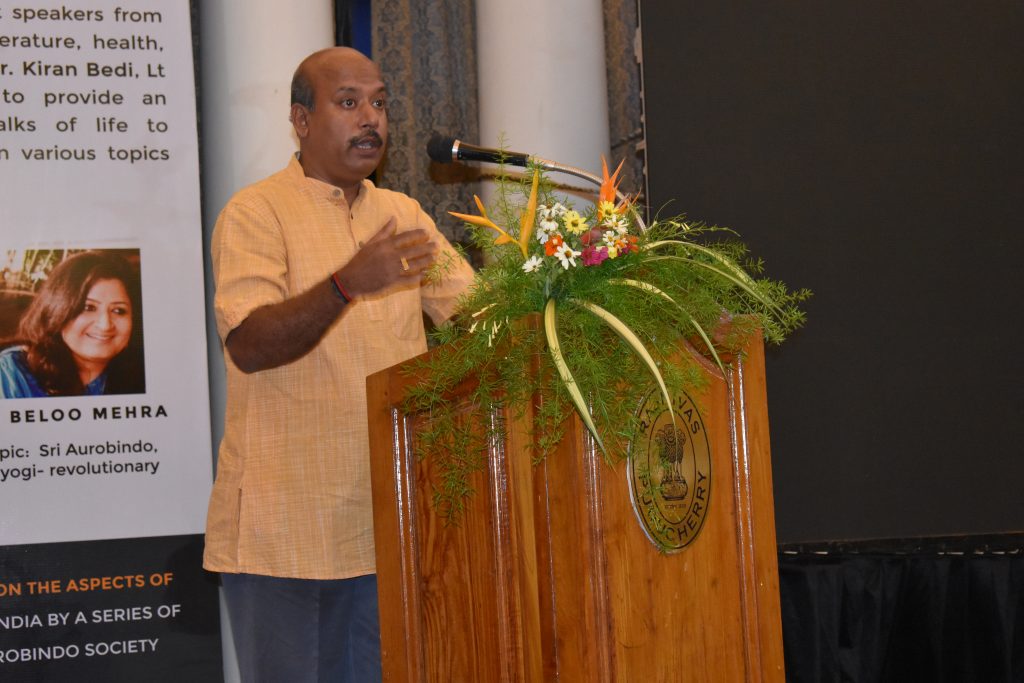
Dr. Mishra briefly narrated a short story from Kenopanishad to demonstrate that without the force of the Divine Mother, the Creatrix, nothing moves in the entire creation, and all the cosmic powers, the gods, too derive their strength from Aditi, the mother of gods. Pointing out that in the psychological and spiritual interpretation of the Veda of Sri Aurobindo all the Vedic deities are names, powers, personalities of universal Godhead, each representing some essential puissance of the Divine Being, it becomes significant to note that almost all the deities which represent the higher supramental faculties that an aspirant seeks to develop are in fact the female deities, the goddesses. He also mentioned that the soul qualities which every human being must develop as part of an integral development of the being are also essentially feminine in nature.
Dr. Kiran Bedi honoured Dr. Mishra by presenting a shawl.
Address by Dr. Kiran Bedi
Ms. Asha Gupta then requested Dr. Kiran Bedi to address the gathering.
Dr. Bedi thanked both the speakers for their spirited lectures, and also the audience for attending this significant programme. She said that the real significance of this evening’s event is that this was the first time a programme dedicated to Sri Aurobindo was being held at Raj Nivas. And that ever since she took over as the Lieutenant-Governor of Puducherry she had been really wanting to host some special event to bring Sri Aurobindo in Raj Nivas. She shared that this evening’s event has turned out to be the best way to make that vision a reality. Adding that this is only a beginning, she said that she would like to see more of such events happening at Raj Nivas.
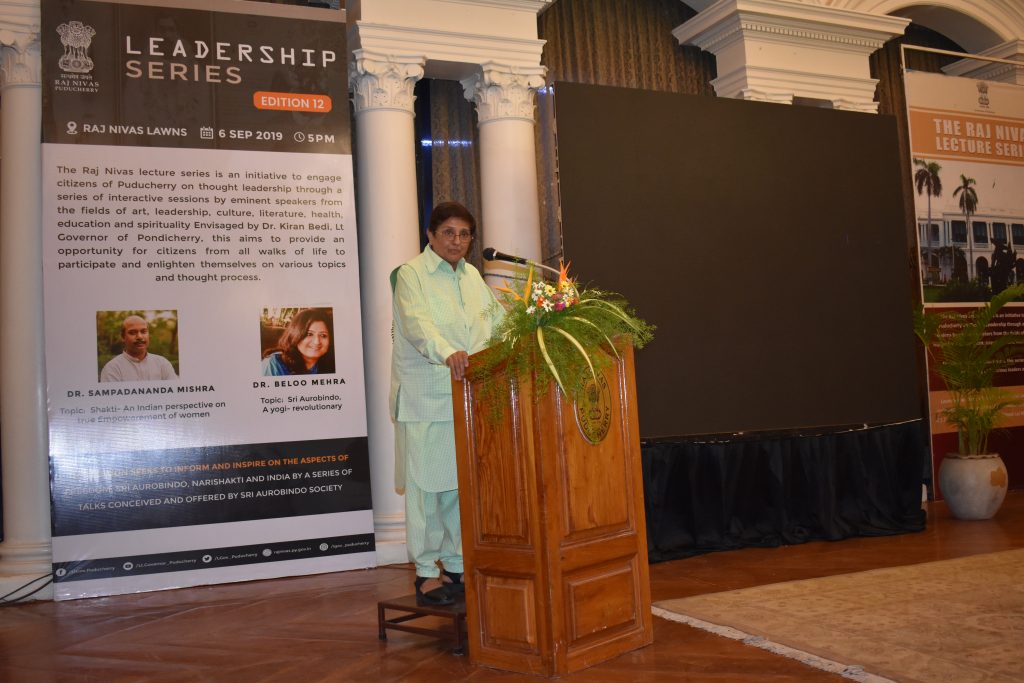
Appreciating the work done for both the exhibitions, Dr. Bedi told the audience that she has gone through all the posters herself and is deeply impressed by the depth of knowledge and history shared through the content displayed. She shared how she was so moved by some of the content she read, particularly about the letter Sri Aurobindo had written to his wife in 1905 expressing his deep aspiration and love for India and seeking for the Divine.
She emphasised that it is important for the youth of Puducherry, the children of Puducherry to know about this history of India, the role of Sri Aurobindo, the sage of Pondicherry, in India’s freedom movement. She added that the Nāri Shakti exhibition can be a great way to help the youth develop an appreciation for the Indian perspective of true women empowerment.
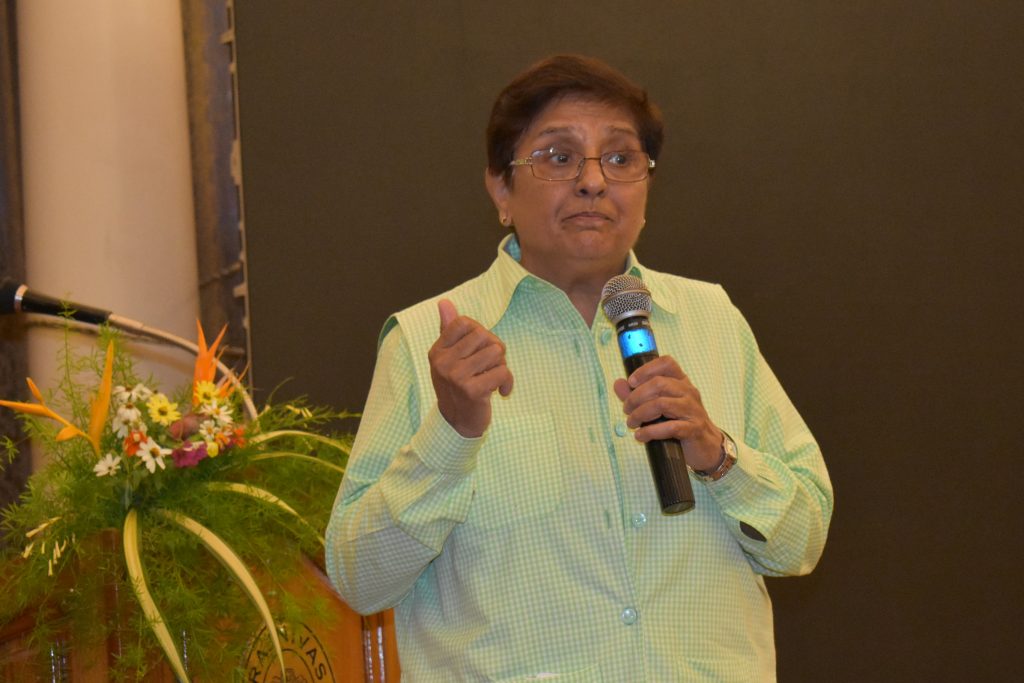
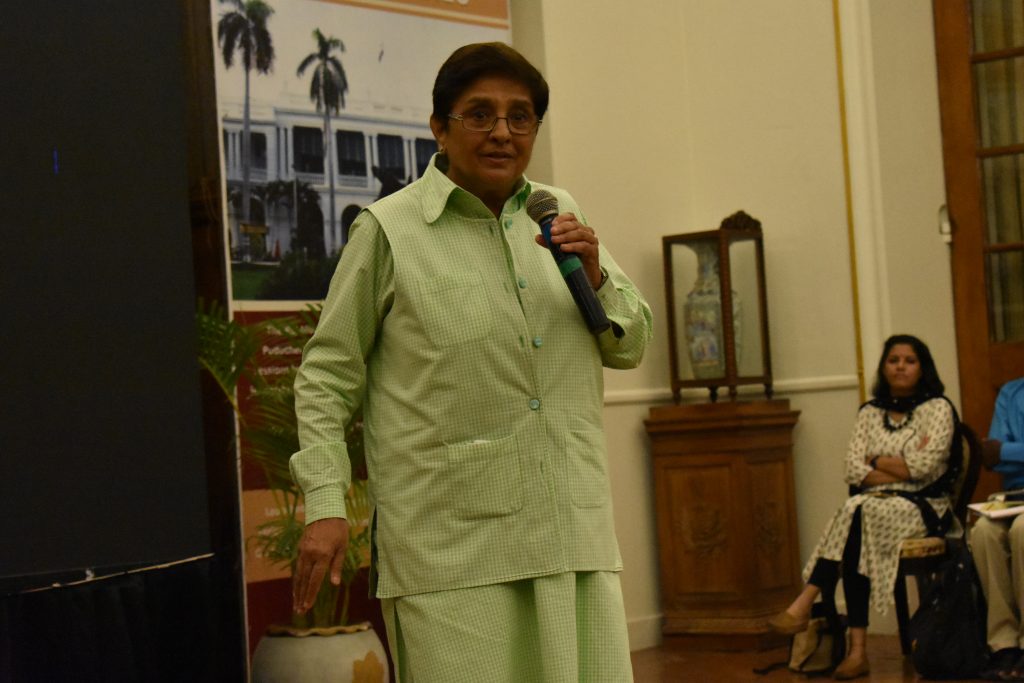
Dr. Bedi announced that she has directed her team to organise visits by children from various schools of Puducherry to Raj Nivas so they can see both the exhibitions in the days and weeks to come. She suggested that SAFIC could help arrange a teacher who can guide the students as they walk through the exhibitions and answer any questions they may have. She also suggested that perhaps essay competitions on related topics can be organised in order to further encourage the students.
To the delight of all the members present at the event, Dr. Bedi said that she will be working out a plan in order to make the exhibition on Sri Aurobindo a permanent exhibit at the Raj Nivas, so that all visitors from all walks of life can learn about Sri Aurobindo, the great yogi-revolutionary, the great Rishi of modern India. This way, Raj Nivas, the official residence of the Lt-Gov of Puducherry, which truly belongs to all the people of Puducherry, can play a key role in spreading the message of Sri Aurobindo’s vision for the future of India and the world.
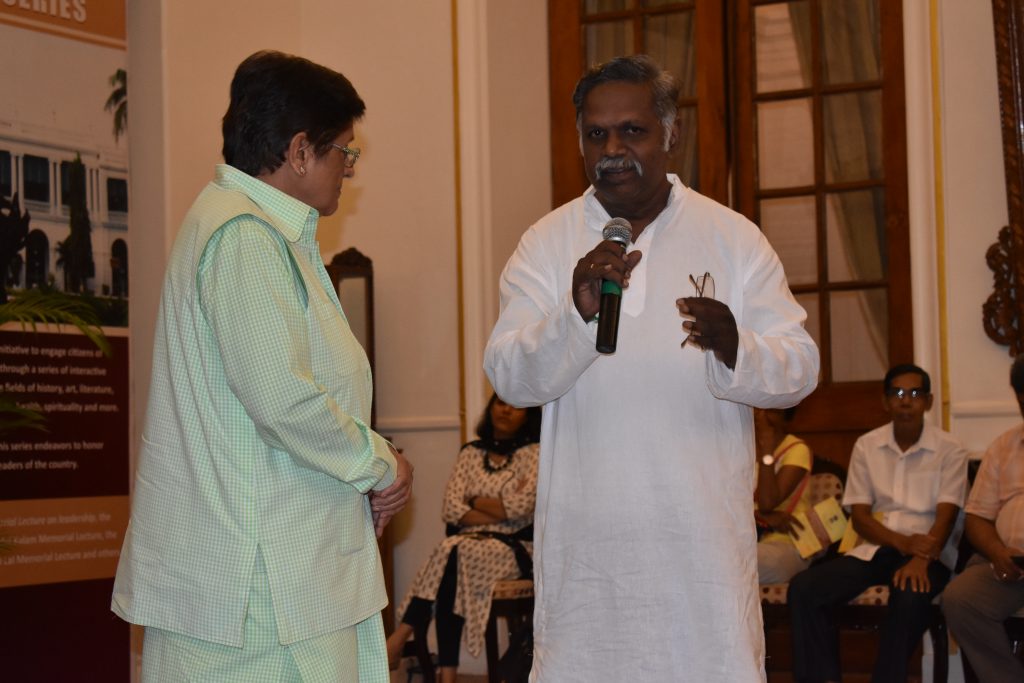
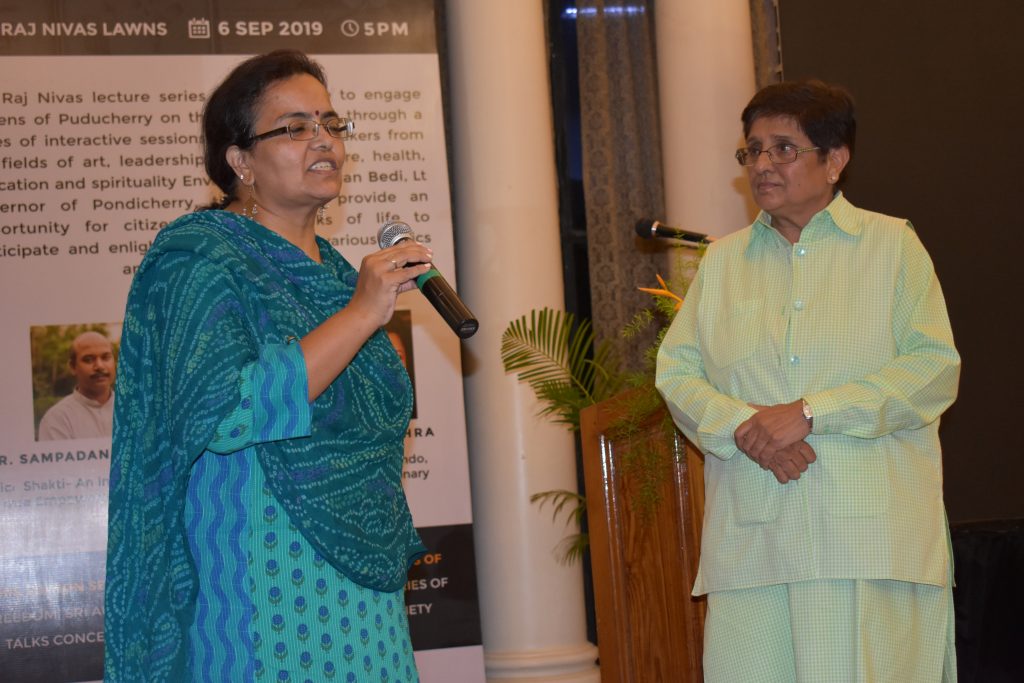
Dr. Bedi thanked Sri Aurobindo Society for bringing this important programme to Raj Nivas. She also thanked the audience for coming to this important event in the history of Raj Nivas. And she reiterated her commitment to ensure that the message of both the exhibitions reaches to as many youths of Puducherry as possible through the efforts of Raj Nivas.
Another short video clip was shown documenting the great sacrifices made by so many Indians from all walks of life in the history of Indian freedom movement.
Ms. Asha Gupta briefly thanked the gathering for making the event a sublime experience for all. She requested all to stand up to National Anthem as a way to close the programme.
In a warm and affectionate gesture, Dr. Bedi invited all the guests to take some refreshments in the adjoining hall.

Overall the event was a great success. Dr. Bedi and the Raj Nivas team have created a WhatsApp group so that all the interested guests from the event can stay connected. This could also serve as a forum for generating more ideas for future educational programmes related to Sri Aurobindo.
